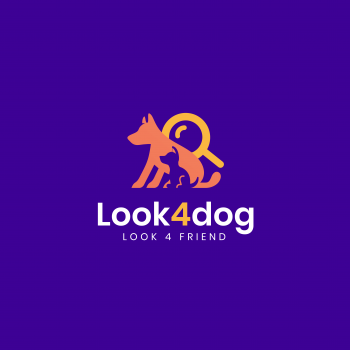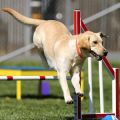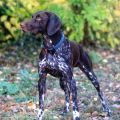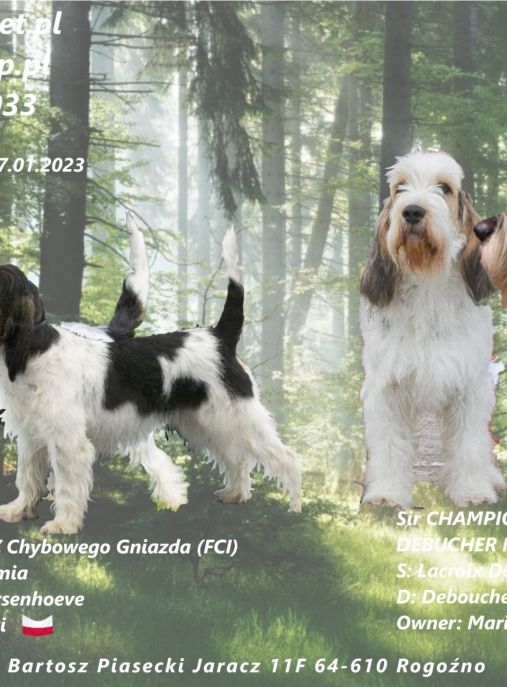Grand Basset Griffon Vendeen - the breed description to be published.
The Grand Basset Griffon Vendéen, also known as the GBGV, is a charming and lively breed of dog that hails from France. With their distinctive long ears, shaggy coat, and expressive eyes, these dogs possess a character that is as unique as their appearance. Let's delve into the character of Grand Basset Griffon Vendéen dogs, their behavior, and how to raise and train them.
Grand Basset Griffon Vendéens are known for their friendly and outgoing nature. They are sociable dogs that love being around people and other animals. Their affectionate disposition makes them excellent family pets and they get along well with children. However, they do have a strong hunting instinct, so it's important to supervise their interactions with smaller pets.
These dogs are intelligent and independent thinkers. While this can make training a bit challenging, it also means they have the potential to excel in various activities such as obedience, agility, and tracking. Early socialization and consistent, positive reinforcement training are crucial to ensure they grow up to be well-behaved and obedient companions.
Grand Basset Griffon Vendéens are energetic and require regular exercise to keep them happy and healthy. They enjoy long walks, hikes, and playtime in a securely fenced yard. Mental stimulation is equally important, as these dogs thrive when given tasks to complete or puzzles to solve. Engaging them in activities like scent work or interactive toys can help channel their energy and prevent boredom.
Due to their hunting background, Grand Basset Griffon Vendéens have a strong sense of smell and an instinct to follow scents. This can sometimes lead to them becoming easily distracted during walks or outdoor activities. It's essential to train them to have a reliable recall and use a secure leash or harness to prevent them from wandering off.
When it comes to grooming, the GBGV's shaggy coat requires regular maintenance. Weekly brushing helps prevent matting and keeps their fur looking tidy. They are moderate shedders, so expect some loose hair around the house. Additionally, their long ears should be checked and cleaned regularly to avoid infections.
To raise a well-rounded Grand Basset Griffon Vendéen, it's important to provide them with mental and physical stimulation, as well as plenty of socialization opportunities. Enrolling them in puppy classes or obedience training can help them develop good manners and learn to interact appropriately with other dogs and people.
Patience, consistency, and positive reinforcement are key when training a GBGV. Harsh methods or punishment can lead to stubbornness or fearfulness. Instead, use rewards, praise, and treats to motivate and encourage them. They respond well to positive reinforcement techniques like clicker training.
In conclusion, Grand Basset Griffon Vendéens are friendly, intelligent, and energetic dogs that make wonderful companions. With proper training, socialization, and exercise, they can thrive in various environments. Their unique character and charming appearance make them a delightful addition to any dog-loving family.
The Grand Basset Griffon Vendeen (GBGV) is a charming and energetic breed known for its long ears, shaggy coat, and friendly disposition. To ensure the well-being and happiness of your GBGV, it is essential to provide them with proper care and attention. Here are some tips on how to care for dogs of this breed, including what to do and what not to do:
1. Grooming: The GBGV has a dense, double coat that requires regular grooming. Brush their coat at least once a week to prevent matting and remove loose hair. Pay special attention to their ears, as they are prone to infections. Clean their ears weekly and check for any signs of redness, swelling, or discharge.
2. Bathing: While the GBGV doesn't need frequent baths, it is important to keep them clean. Bathe them every 2-3 months or as needed, using a mild dog shampoo. Avoid over-bathing, as it can strip their coat of natural oils, leading to dry skin.
3. Exercise: GBGVs are active dogs that require regular exercise to stay healthy and happy. Aim for at least 30-60 minutes of exercise daily, including brisk walks, jogging, or playtime in a securely fenced yard. Mental stimulation is equally important, so provide them with puzzle toys or engage in obedience training sessions.
4. Socialization: GBGVs are social dogs that thrive on human companionship. Expose them to various people, animals, and environments from an early age to ensure they grow up to be well-rounded and confident. Enroll them in puppy classes or obedience training to enhance their social skills.
5. Nutrition: Feed your GBGV a balanced and high-quality diet that suits their age, size, and activity level. Consult with your veterinarian to determine the appropriate portion sizes and feeding schedule. Avoid overfeeding, as GBGVs can be prone to obesity, which can lead to various health issues.
6. Health care: Regular veterinary check-ups are crucial for maintaining your GBGV's health. Ensure they receive all necessary vaccinations, parasite prevention, and annual dental cleanings. GBGVs are generally healthy dogs, but they may be prone to certain conditions like hip dysplasia, ear infections, and eye problems. Regularly inspect their eyes, teeth, and joints for any signs of discomfort or abnormalities.
7. Mental stimulation: GBGVs are intelligent dogs that require mental stimulation to prevent boredom and destructive behavior. Engage them in interactive games, teach them new tricks, or provide them with puzzle toys to keep their minds active and engaged.
What NOT to do:
1. Neglect exercise: GBGVs are active dogs, and lack of exercise can lead to behavioral issues like excessive barking, digging, or chewing. Avoid confining them for long periods without exercise or mental stimulation.
2. Leave them alone for extended periods: GBGVs are social dogs and can suffer from separation anxiety if left alone for too long. If you have a busy schedule, consider hiring a dog walker or providing them with interactive toys to keep them occupied.
3. Use harsh training methods: GBGVs respond best to positive reinforcement training techniques. Avoid using harsh punishments or physical corrections, as it can damage their trust and lead to fear-based behaviors.
4. Ignore their grooming needs: Neglecting regular grooming can result in painful matting, skin infections, and discomfort for your GBGV. Stay consistent with their grooming routine to keep them clean and healthy.
5. Overfeed or feed inappropriate food: GBGVs have a tendency to gain weight, so avoid overfeeding or giving excessive treats. Stick to a balanced diet recommended by your veterinarian and avoid feeding them table scraps or foods that are toxic to dogs.
By following these tips and providing your Grand Basset Griffon Vendeen with love, care, and attention, you can ensure they lead a happy and fulfilling life as a cherished member of your family.
The Grand Basset Griffon Vendeen, also known as the GBGV, is a charming and distinctive breed of dog that boasts a unique coat color. These dogs are known for their striking and eye-catching appearance, which is primarily characterized by their common coloration.
The most common color of Grand Basset Griffon Vendeen dogs is a rich and warm shade of fawn. This color can vary in intensity, ranging from a light, sandy hue to a deeper, reddish tone. The fawn color is often described as a combination of golden and tan shades, creating a beautiful and harmonious blend.
The fawn color of the GBGV's coat is typically distributed evenly throughout their body, with no specific patterns or markings. This uniformity adds to the breed's elegance and gives them a sleek and polished appearance. The fawn coloration is most prominent on the dog's back, sides, and hindquarters, creating a stunning contrast against their white underbelly and chest.
In addition to the fawn color, Grand Basset Griffon Vendeens may also have small patches of white on their chest, paws, and tail tip. These white markings add a touch of brightness and further enhance the overall beauty of their coat. However, it is important to note that excessive white markings are not desirable in the breed standard and may be considered a fault.
The fawn color of the GBGV's coat is not only visually appealing but also serves a practical purpose. It provides excellent camouflage in their natural hunting environment, allowing them to blend seamlessly with their surroundings. This coloration enables them to approach their prey with stealth and agility, making them highly effective hunters.
The fawn color of the Grand Basset Griffon Vendeen's coat is not only aesthetically pleasing but also serves as a testament to their breed's rich history and heritage. This color has been carefully preserved and cherished by breeders for generations, ensuring that the GBGV remains true to its origins.
In conclusion, the common color of Grand Basset Griffon Vendeen dogs is a beautiful and warm fawn shade. This color, ranging from light to dark, is evenly distributed throughout their body, with no specific patterns or markings. The fawn coloration, along with small patches of white, adds to the breed's elegance and enhances their overall appearance. It is a testament to their breed's history and serves a practical purpose in their hunting abilities.
The Grand Basset Griffon Vendeen (GBGV) is a charming and energetic breed known for its long, low-set body and shaggy coat. While generally a healthy breed, like all dogs, they are prone to certain health issues. Understanding these common diseases and taking appropriate care can help ensure the overall well-being of your GBGV.
One of the most prevalent health concerns in GBGVs is hip dysplasia. This condition occurs when the hip joint doesn't develop properly, leading to pain, lameness, and arthritis. Regular exercise, maintaining a healthy weight, and avoiding excessive jumping or rough play can help reduce the risk of hip dysplasia. Responsible breeders often perform hip evaluations on their breeding stock to minimize the occurrence of this condition.
Another common health issue in GBGVs is ear infections. Their long, droopy ears can trap moisture and debris, creating a favorable environment for bacteria and yeast to grow. Regular ear cleaning with a veterinarian-recommended solution and routine grooming to keep the ears dry can help prevent infections. Additionally, it's essential to regularly check and clean your GBGV's ears after outdoor activities or swimming.
Like many other breeds, GBGVs can also suffer from allergies. Allergies can manifest as skin irritations, itching, and gastrointestinal issues. Identifying and avoiding allergens, such as certain foods, pollen, or environmental triggers, can help manage allergies. In severe cases, your veterinarian may recommend allergy testing or prescribe medication to alleviate symptoms.
Patellar luxation, a condition where the kneecap dislocates, is another health concern in GBGVs. This can cause lameness, pain, and difficulty walking. Regular exercise, maintaining a healthy weight, and avoiding excessive jumping or strenuous activities can help reduce the risk of patellar luxation. In severe cases, surgical intervention may be necessary to correct the condition.
Additionally, GBGVs are prone to certain eye conditions, including cataracts, progressive retinal atrophy (PRA), and glaucoma. Regular eye examinations by a veterinary ophthalmologist can help detect and manage these conditions. Prompt treatment and regular monitoring are crucial to preserve your GBGV's vision.
To ensure the overall health of your GBGV, regular veterinary check-ups are essential. Vaccinations, parasite prevention, and dental care should be part of their routine healthcare. A balanced diet, appropriate exercise, and mental stimulation are also crucial for their well-being. GBGVs are active dogs that require regular exercise to prevent obesity and maintain muscle tone.
Grooming is another important aspect of caring for a GBGV's health. Their shaggy coat requires regular brushing to prevent matting and remove debris. Bathing should be done as needed, using a gentle dog shampoo to maintain the coat's natural oils. Regular dental care, including brushing their teeth and providing dental chews, can help prevent dental diseases.
In conclusion, while the Grand Basset Griffon Vendeen is generally a healthy breed, they can be prone to certain health issues. Understanding and addressing these common diseases, along with regular veterinary care, proper nutrition, exercise, and grooming, can help ensure a long and healthy life for your beloved GBGV.
The Grand Basset Griffon Vendeen (GBGV) is a medium-sized breed known for its friendly and outgoing nature. To ensure their overall health and well-being, it is crucial to provide them with a balanced and nutritious diet. Proper nutrition plays a vital role in maintaining their energy levels, promoting healthy growth, and preventing various health issues. Here is an extensive description of the nutrition requirements for GBGV dogs, along with advice on feeding and what to avoid.
Protein is an essential component of a GBGV's diet, as it aids in muscle development and repair. High-quality animal-based proteins such as chicken, turkey, beef, and fish should be the primary source of protein. These can be provided through commercial dog food or homemade meals. It is important to ensure that the protein content is appropriate for the dog's age, size, and activity level. Consult with a veterinarian to determine the ideal protein percentage for your GBGV.
Carbohydrates are another crucial part of a GBGV's diet, providing them with energy. Opt for complex carbohydrates like whole grains (brown rice, oats, quinoa) and vegetables (sweet potatoes, carrots, peas). These sources are rich in fiber, which aids in digestion and helps regulate blood sugar levels. Avoid feeding your GBGV excessive amounts of simple carbohydrates, such as refined grains and sugary treats, as they can lead to weight gain and dental issues.
Fats are an important source of energy and help in the absorption of fat-soluble vitamins. Incorporate healthy fats into your GBGV's diet through sources like fish oil, flaxseed oil, and chicken fat. These fats provide essential fatty acids, such as omega-3 and omega-6, which promote healthy skin and coat. However, it is crucial to monitor the fat intake, as excessive amounts can lead to obesity and related health problems.
Vitamins and minerals are necessary for a GBGV's overall health and immune system support. A well-balanced diet should include a variety of fruits and vegetables to provide essential vitamins and minerals. However, it is important to note that some fruits, like grapes and raisins, can be toxic to dogs and should be avoided. Consult with a veterinarian to determine the appropriate vitamin and mineral supplements, if necessary.
Feeding guidelines for GBGV dogs vary depending on their age, size, and activity level. Puppies require more frequent meals, typically three to four times a day, to support their rapid growth. As they mature, the number of meals can be reduced to two times a day. Portion sizes should be determined based on the dog's weight, with guidance from a veterinarian. Avoid overfeeding, as GBGVs are prone to obesity, which can lead to joint problems and other health issues.
It is important to provide fresh and clean water at all times to keep your GBGV hydrated. Avoid feeding them table scraps, as these can be high in fat, salt, and spices, which may upset their digestive system or lead to obesity. Additionally, certain human foods like chocolate, onions, garlic, and avocados can be toxic to dogs and should be strictly avoided.
In conclusion, a well-balanced and nutritious diet is essential for the health and well-being of Grand Basset Griffon Vendeen dogs. Providing them with high-quality proteins, complex carbohydrates, healthy fats, and a variety of fruits and vegetables will help meet their nutritional needs. Regular consultations with a veterinarian can ensure that your GBGV's diet is appropriate for their specific requirements. By following these guidelines and avoiding harmful foods, you can help your GBGV live a long, healthy, and happy life.






